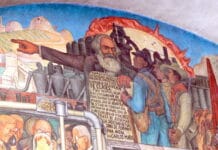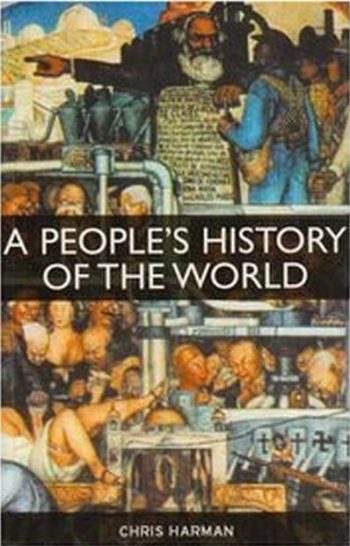Linkbox med anmeldelser og interviews om Chris Harmans bog, “A People’s History of the World”, samt bogen online. Plus en ’Se også’ om kapitalismens oprindelse mv.
(Bjarne A. Frandsen, december 2009; revideret november 2019)
A People’s History of the World
By Chris Harman (Bookmarks, 1999, 729 pages. Reprint at Verso, 2008)
“From earliest human society to the Holy Roman Empire, from the Middle Ages to the Enlightenment, from the Industrial Revolution to the end of the millennium, Chris Harman provides a brilliant and comprehensive history of the planet.”
Interview with Chris Harman about the book (Socialist Worker, Issue 2100, 10 May 2008)
Se også på Socialistisk Bibliotek:
Personlisten: Chris Harman (1942-2009)
Reviews:
A classic work republished. By John Molyneux (Irish Marxist Review, Vol.7, No.20, 2018, p.61-64). “This is a great service to both historiography and to the socialist movement … What follows is an extract of the review I wrote of this magnificent book at the time [see Socialist Review below].”
Taking apart the west. By Richard Seymour (New Statesman, 24 July 2008; online at Internet Archive)
“Harman has, with impressive narrative sweep, delivered a sophisticated attack on many prevailing assumptions, not least of which is the complacent faith in capitalism’s durability.”
Socialists and history: a battle for the past (Socialist Worker, Issue 2100, 10 May 2008)
“The book has just been republished by Verso in an edition for the US as well as Britain. Chris Harman spoke to Socialist Worker about the book.”
The big picture. By Dean Ferguson (MR Online, May 24, 2007)
“Within the brief compass of this review, it is impossible to do more than suggest the scope of Harman’s achievement. This is a massive work, its careful scholarship leavened by the author’s passionate commitment.”
Reviewing the millennia. By Robin Blackburn (International Socialism, Issue 86, Spring 2000)
“The dovetailed accounts of historical developments across seven or eight millennia are always interesting, usually well informed and sometimes highly original. The left has no dearth of polemics concerning the major events of the 20th century. On the other hand it has few accounts which convey as well as this book does the broad sweep of human history.”
Review by Al Richardson (Revolutionary History, Vol.7, No.4, Winter 2000-2001). “The writer of this book is to be commended for his audacity in attempting such a mammoth task. It is well conceived and logically developed, and the range of the author’s reading is quite astonishing. But it is equally plain that he has bitten off more than he can chew.”
Living in a material world. By John Molyneux (Socialist Review, Issue 235, November 1999; online at Internet Archive)
“Now for the first time we have an accessible and serious Marxist account of the whole damn story which can be counterposed at every point to the bourgeois view … it is a totalising account which tells the story of humanity from our emergence as a distinct species to the present day. As such, it is an awesome achievement.”
History to make a future. By Mark Steel (Socialist Worker, Issue 1672, 13 November 1999)
“This book is more than a series of fascinating but disconnected facts. Each section conveys how the facts of history are anything but disconnected, and can only be fully explained by a Marxist approach.” Scroll down.
Online edition:
The book online:
Bookmarks Edition (1999; online at IS Tendency/Internet Archive)
Verso Edition (2008; online at Libcom)
Extracts from the book at Marxists Internet Archive:
Introduction (p.i-vii)
Part one: The rise of class societies
- Chronology (p.2)
- Prolouge: Before class (p.3-9)
- Chapter 1: The neolithic ‘revolution’ (p.10-16)
- Chapter 2: The first civilisations (p.17-21)
- Chapter 3: The first class division (p.22-28)
- Chapter 4: Women’s oppression (p.29-31)
- Chapter 5: The first ‘Dark Ages’ (p.32-41)
Part two: The ancient world
- Chronology (p.44)
- Chapter 1: Iron and empires (p.45-47)
- Chapter 2: Ancient India (p.48-53)
- Chapter 3: The first Chinese empires (p.54-62)
- Chapter 4: The Greek city states (p.63-70)
- Chapter 5: Rome’s rise and fall (p.71-86)
- Chapter 6: The rise of Christianity (p.87-100)
Part three: The ‘Middle Ages’
- Chronology (p.102)
- Chapter 1: The centuries of chaos (p.103-105)
- Chapter 2: China: the rebirth of the empire (p.106-116)
- Chapter 3: Byzantium: the living fossil (p.117-122)
- Chapter 4: The Islamic revolutions (p.123-135)
- Chapter 5: The African civilisations (p.136-139)
- Chapter 6: European feudalism (p.140-158)
Part four: The great transformation
- Chronology (p.160)
- Chapter 1: The conquest of the New Spain (p.161-171)
- Chapter 2: Renaissance to Reformation (p.172-193)
- Chapter 3: The birth pangs of a new order (p.194-218)
- Chapter 4: The last flowering of Asia’s empires (p.219-229)
Part five: The spread of the new order
- Chronology (p.232)
- Chapter 1: A time of social peace (p.233-236)
- Chapter 2: From superstition to science (p.237-241)
- Chapter 3: The Enlightenment (p.242-246)
- Chapter 4: Slavery and wage slavery (p.247-248)
- Chapter 5: Slavery and racism (p.249-256)
- Chapter 6: The economics of ‘free labour’ (p.257-262)
Part six: The world turned upside down
- Chronology (p.264)
- Chapter 1: American prologue (p.265-276)
- Chapter 2: The French Revolution (p.277-202)
- Chapter 3: Jacobinism outside France (p.303-314)
- Chapter 4: The retreat of reason (p.315-317)
- Chapter 5: The industrial revolution (p.318-325)
- Chapter 6: The birth of Marxism (p.326-334)
- Chapter 7: 1848 (p.335-344)
- Chapter 8: The American Civil War (p.345-354)
- Chapter 9: The conquest of the East (p.355-364)
- Chapter 10: The Japanese exception (p.365-367)
- Chapter 11: Storming heaven: The Paris Commune (p.368-373)
Part seven: The century of hope and horror
- Chronology (p.377-378)
- Chapter 1: The world of capital (p.379-404)
- Chapter 2: World war and world revolution (p.405-429)
- Chapter 3: Europe in turmoil (p.430-448)
- Chapter 4: Revolt in the colonial world (p.449-462)
- Chapter 5: The ‘Golden Twenties’ (p.463-468)
- Chapter 6: The great slump (p.469-492)
- Chapter 7: Strangled hope: 1934-36 (p.491-509)
- Chapter 8: Midnight in the century (p.510-542)
- Chapter 9: The Cold War (p.543-576)
- Chapter 10: The new world disorder (p.577-601)
- Conclusion: Illusion of the epoch (p.604-620)
- Notes (p.621-661)
- Glossary: People – Places – Terms (p.663-686)
- Further Reading (p.687-693)
See also:
The origins of capitalism. By Chris Harman (International Socialism, No.111, Summer 2006, p.127-162)
“This is the transcript of the discussion which took place between Chris Harman and Robert Brenner at a school in London in November 2004 organised jointly by the journals International Socialism and Historical Materialism.”
The rise of capitalism. By Chris Harman (International Socialism, No.102, Spring 2004, p.53-86)
“Chris Harman seeks to explain why and how capitalism developed in the first place. Why did the once great feudal empires of the Middle East and and Japan stagnate and fall behind? How did northern Europe leap ahead of the rest of the world?”
A Marxist History of the World: From Neanderthals to Neoliberals. By Neil Faulkner (Pluto Press, 2013, 342 p.). Most of the book has been published at Counterfire (Part 1-106 + 5 more chapters, June 3, 2010 – November 18, 2013)
See review by Sean Ledwith (Marx & Philosophy Review of Book, 29 May 2014) + review by Andrew Stone: A history of struggle (International Socialism, Issue 141, Winter 2014). New revised edition: A Radical History of the World (Pluto Press, 2018, 580 p.).*
See also videos: The History Fix: A Radical History of the World (YouTube, 19 November 2018). 26 lectures by Neil Faulkner. From Ep1: Who are we and what makes us human? to Ep26: What is Class?































![Hugo Gellert (May 3, 1892 – December 9, 1985) var en ungarnsk-Amerikansk illustrator and murmaler. Han illustrerede en udgave af Karl Marx' 'Capital' in Lithographs, New York 1934. De valgte illustrationerer er fra side 3 Primary Accumulation, Secret of primary accumulation [2 of 3], side 14. PRIMARY ACCUMULATION, Origin of the industrial capitalist [1/5] og side 19. PRIMARY ACCUMULATION, Historical tendency of capitalist accumulation](https://socbib.dk/wp-content/uploads/2018/01/Kapitalen_Hugo_Gellert-100x70.jpg)
